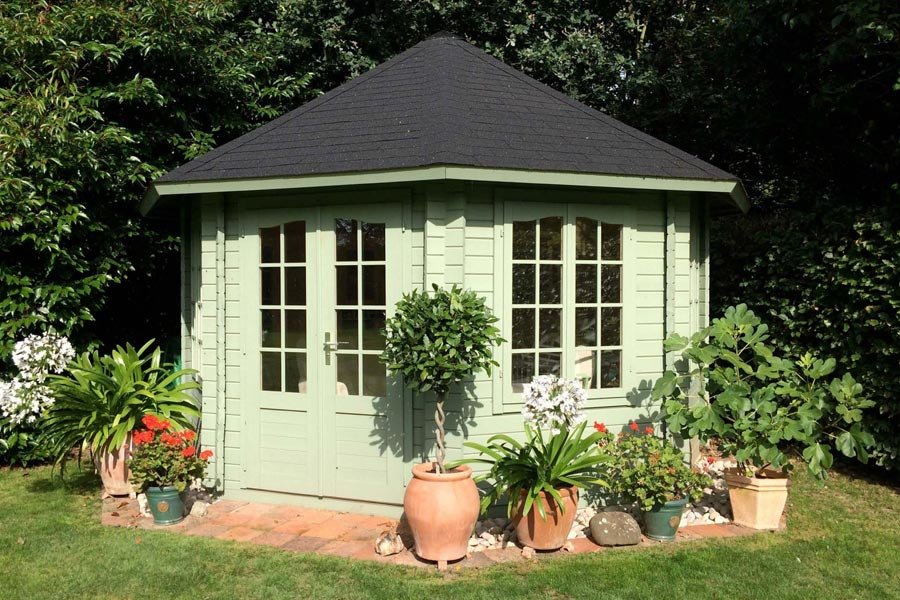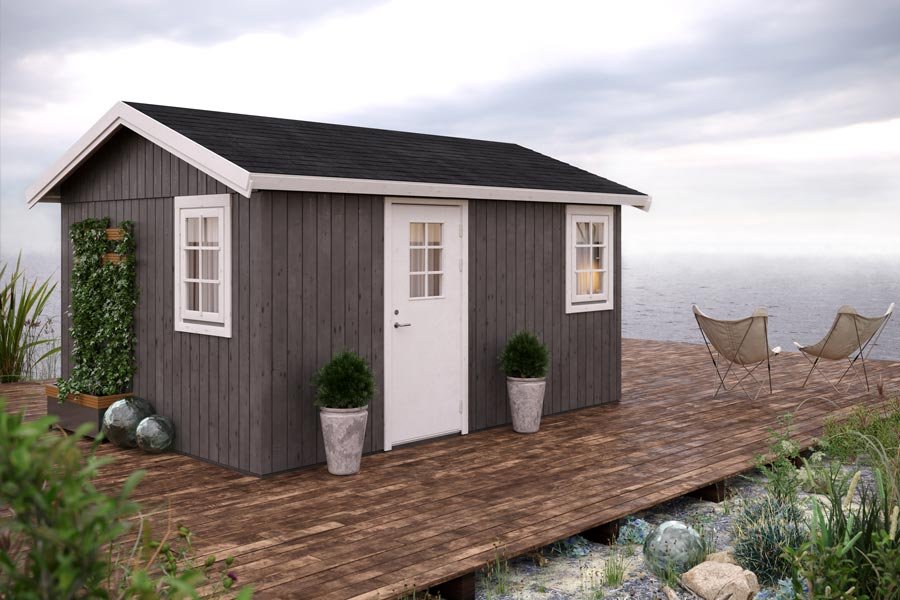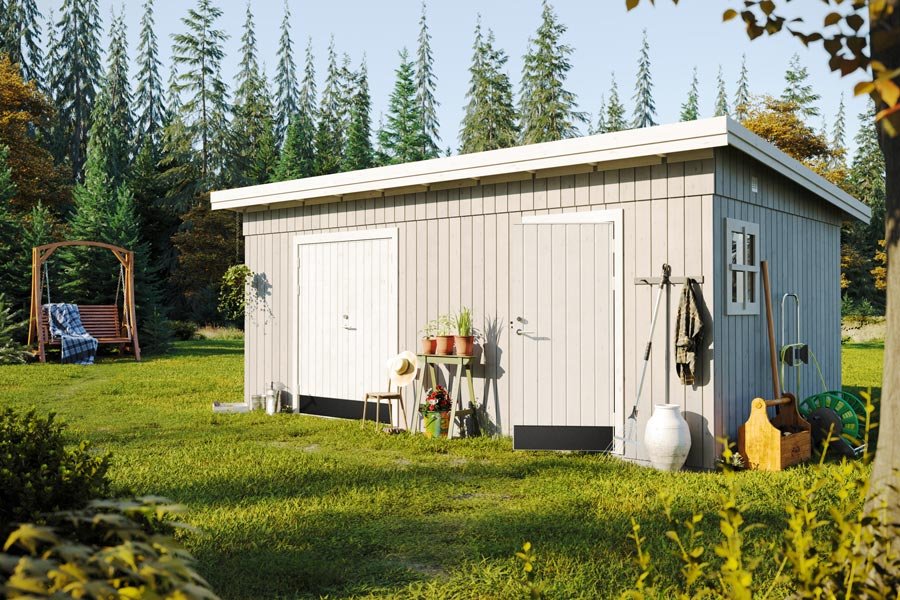
by Mark Bailey | Oct 23, 2018 | GardenLife Magazine

The best gardens to visit this autumn?
Autumn, with its orange, red and ochre colour palette, is a sweet spot when it comes to gardens. Sandwiched between baking summer weather and winter’s short cold days, it is a beautiful season.
Many of the British Isles’ gardens, parks and stately homes look their most glorious in October and November. So, we’ve picked some of our favourite gardens around England, Scotland, Wales and Northern Ireland. Any of which is fit for a visit in the season of mellow fruitfulness.
You could go for a day out with family and friends, some garden inspiration, or to help children or pets burn off some energy. So, what are some of the best gardens to visit this autumn?
Visiting Sheffield Park and Garden in autumn

You’d be forgiven for thinking this spectacular park, complete with four ornamental lakes and dense woodland, is in Sheffield. It is however in East Sussex.
Once a WW2 camp and a deer park, it’s now a terrifically Instagram-friendly setting. Its reflections of autumnal trees in the lakes attract thousands of photo-hungry visitors every year. There are numerous glades, wooded areas, paths and tree varieties – ideal for gardeners and those who want a peaceful, rural stroll.
It’s also very family friendly (you can even arrive by the nearby steam train), and it’s open all year round. If you’re into photography, Sheffield Park is definitely one of the best gardens to visit this autumn.
Hillier Gardens are full of autumn colour
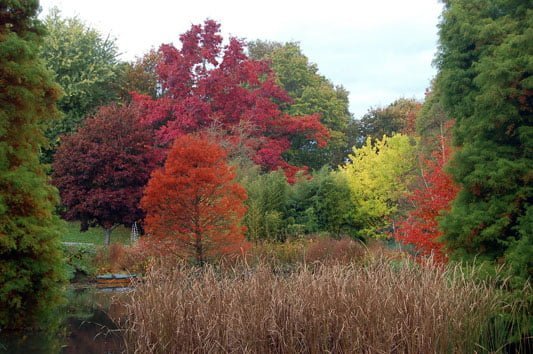
Another great autumn garden in Southern England is Hillier Gardens, in Hampshire, which really comes into its own in the autumn months. If you’re looking for inspiration, take a look at the valley of Japanese maples (‘Acer Valley’). The various plantings of shrubs and perennials are great examples of how to keep colour in your garden well into autumn and winter.
This is another child-friendly option, thanks to a butterfly park, bamboo wood chimes and an education centre. It’s open all year, and children under 5 can get in free. Dogs, on the other hand, are banned.
View further details of prices and opening times.
Castle Howard has a bit of everything

For those of a certain age, Castle Howard will be familiar from the 1980s TV series Brideshead Revisited (starring Jeremy Irons), which was filmed in its grounds. Scenes from the TV series Victoria and a Garfield film were also shot here.
The more active may know it for the Triathlon series held there each summer.
Near Leeds and York, its vast grounds house walled gardens, woodlands, lakes and even a temple and tree nursery. It’s open year-round, is dog-friendly and is one of the best gardens to visit this autumn.
Castle Howard is a full-scale commercial operation, so the events programme is packed. Autumn events include child-friendly Halloween bashes, followed by Twelve Days of Christmas events. Regular visits from Father Christmas start at the beginning of November too.
If you confine your visit to the garden centre, entry is free, otherwise, you need a ticket.
Hergest Croft Gardens, a Welsh autumnal treat

In the heart of the Welsh Marches, with views towards the Black Mountains, lie the Hergest gardens, home to the UK’s ‘national collection’ of maple and birch trees, among others.
The 70-odd acres of trees and shrubs are particularly attractive from October onwards. Dogs and picnics are allowed, and kids go free with adults (the common is perfect for running off some energy).
If you’re planning a visit, you’ll need to act quickly – it closes at the end of the October until March. But if buy a season ticket holder, you can visit all year.
For more information on these beautiful Herefordshire gardens visit the website.
The best gardens to visit in Scotland this autumn?

Further north, in the Scottish Borders, the Dawyck (pronounced “doyk”) gardens stay open until the end of November (before the northern chill sets in properly). They house some displays you’re unlikely to find elsewhere – a four-season moss and fungi reserve, towering trees from the sixteenth century alongside Japanese and American species in glorious orange colours, and fruits and conkers galore.
Autumn garden tours and Halloween themed walks punctuate the autumn events timetable. As part of the Royal Botanic Garden of Edinburgh (RBGE), it’s rather disapproving of leisure though – so it’s definitely not one of the best gardens to visit this autumn if you’re into dogs, throwing balls, playing games or jogging.
If you want a Botanic garden to visit in December, the Edinburgh Botanics will still be open, and there are various cafes where you can warm yourself up during your visit.
Mount Stewart in autumn, Northern Ireland
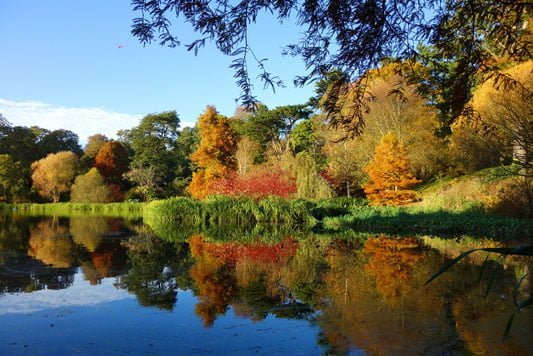
Over the Irish Sea now, to County Down, where the famous Mediterranean-style gardens apparently are based on an Italian villa landscape. Admittedly, autumn in Northern Ireland is hardly Italianate, but there’s plenty to see outside the summer months because it’s planted for all seasons.
As well as walled gardens, landscaping and lakes, Mount Stewart has its own squirrel trail, where you can spot the elusive red species.
There are also plenty of seasonal activities, like Halloween activities in late October and early November. It’s also something of a birdwatchers’ haven and it’s open pretty much year round, although the adjacent Stewart House isn’t.
For more information about prices, opening times and what to see have a look at the Mount Stewart website.
If you’re planning a trip to the UK for next year, check out our earlier guide to the best gardens to visit in the summer months.

by Mark Bailey | Sep 19, 2018 | GardenLife Magazine

Colder months and cooler temperatures call for garden winter-proofing – not just plants and shrubs, but sheds, summer houses, garden rooms, decking and fences too.
In fact, if any timber garden building goes too long without paint or wood preservatives, damp and rot can creep in all too easily. Even the densest timber and highest-quality build structure can be affected.
GardenLife know painting and wood-treatment is not the most exciting of tasks, but it really is worth doing. It can extend the life of a summer house, garden shed, decking or fence by years. So, to help relieve some of that workload, we’re taking a look at some mechanical help, in the form of various types of garden fence sprayer.
Why use a garden fence sprayer?
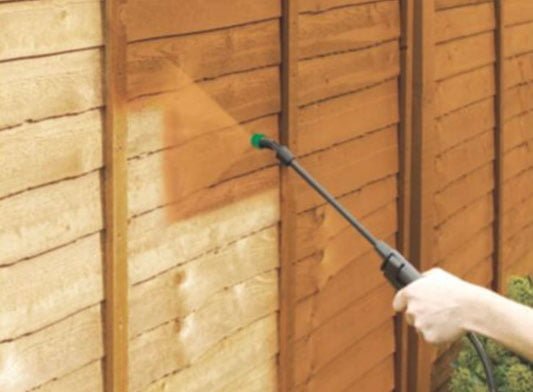
Variously called “pressure sprayers”, “paint sprayers”, “spray guns” or “pump sprayers”, these labour saving devices are made by the likes of Ronseal, Cuprinol, Wagner and B&Q.
In a nutshell, using a shed and garden fence sprayer to apply preservative or paint is far quicker than a brush. You’re also more likely to get better, more even coverage. This in turn will protect the timber more effectively. Many garden fence sprayers have adjustable spray nozzles and speed controls, so you can control how much preservative or paint is used, and easily get into tight corners or small gaps.
You do need to be aware of the need to clean your shed and garden fence sprayer, as well as health and safety precautions, but we’ll guide you through those shortly.
Different power sources for garden fence sprayers
There are three distinct categories of shed and garden fence sprayer: corded, cordless and manual. So we’re going to look at the different types, with their pros and cons, and also mention some of the popular models on the market for each type. Of course, there are many other models available too – but the examples below (and their reviews) will give you a guide to what to look out for if you’re considering other models.
Mains-powered electrical garden fence sprayers
The advantages of electrical sprayers are obvious – as with anything from vacuum cleaners to radios, there’s no faffing about with replacing or recharging batteries, and they’re efficient in terms of power consumption.
Then again, there’s also an obvious disadvantage – namely, the cable. The fact it may not reach to the end of your garden, and the impossibility of finding an extension lead when you need one.
Wagner Electric Garden Shed & Fence Sprayer

At £69.99, this one is a little pricey but it’s versatile and gets mainly 5 star reviews. It has an adjustable spray jet so you can tailor it to the size of panelling you’re working with, and the amount of paint you want to use. The tank is housed separately and can stand on the ground or be carried around with a shoulder strap; its capacity is definitely on the smaller side though at 1.4l, so bear that in mind and be prepared for regular refills
Cordless garden fence sprayers
Cordless shed and garden fence sprayer are generally designed to be versatile and easily portable. They offer the speed and coverage of electric-powered models, without the issue of having a cable dragging round behind you.
But instead you have the battery issue – some are rechargeable and can be used anywhere, but charge times can be long and running times short. Others have traditional batteries, but then you have to keep on buying batteries.
Ronseal Precision Finish Fence Paint Sprayer

At £32 this ticks the boxes on versatility – there are different power and nozzle settings for control, speed and accuracy. The tank itself is a generous 5 litres, but the cord attaching the nozzle is quite short so it’s not idea for some garden or fence layouts.
Reviews are mixed – there are plenty of 5 star reviews from users saying how it saved them hours or days compared to using a brush, but other reviews complain of clogging.
As with all products that get mixed reviews, you want to apply some common sense to what you read. For example, the reviewer who complained about spray going everywhere on a very windy day should probably blame their own choice of spraying day rather than the product!
Manual shed and garden fence sprayers
Manual sprayers come in cheap, sturdy and versatile. But since they need to be pressurised by hand, they’re not great for anything larger than a few fence panels. As you’d expect, both Ronseal and Cuprinol both have popular models, but the following Spear & Jackson sprayer is difficult to beat.
Spear & Jackson Pressure Sprayer for Wood Stain

Cheap and (thanks to its pump mechanism) reliable, it would seem it’s hard to go wrong with this one – the 3 bar pressure level will even discharge a consistent spray for a prolonged period. There’s a 5l tank, easy to clean brass fittings, and it will spray water, weedkiller and chemicals with pH values between 5 and 9 (including water-based wood stain).
With an average of 4 stars from over two thousand reviews, £22.50 represents very good value for money.
Cuprinol pump and brush garden fence sprayer MPSB
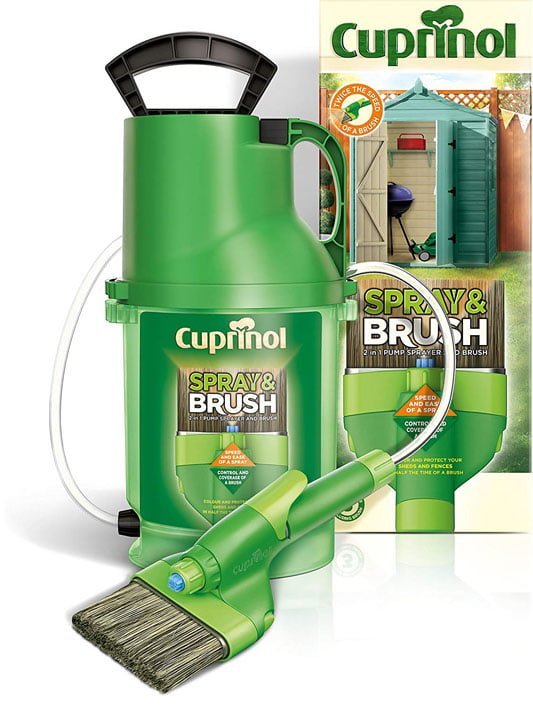
It certainly looks peculiar but this Cuprinol fence sprayer has the novel idea of combining a manually charged sprayer and a brush to add finishing touches. The tank is smaller than some others on this list, and the tank and nozzle are all in the same housing so you have to carry everything around together, but reviews are mostly very positive (and also contain some useful tips about how to get the best results) and it’s only £28.
General tips
With all types of shed and garden fence sprayer, you’ll want to think about the following:
- whether they only work with specific types of preservative or paint (which may limit their use or lock you into expensive products)
- whether you’ll actually be able to carry them once you’ve filled them up with your treatment product
- how easy they’ll be to fill, refill and – crucially – clean
- does the choice of nozzles and length of hose suit you – if you have awkward spaces to reach, are there precision nozzles or extension tubes?
- if you have large expanses of timber to treat, how large is the tank and how fast is the coverage?
- always wear safety gear – goggles, a respirator, gloves and overalls
Finally, even where garden fence sprayers have adjustable nozzles, they can sometimes spray erratically. So, if there are any people, pets, garden structures, windows, plants, ponds or washing lines nearby, proceed with caution (or not at all!).

by Mark Bailey | Aug 23, 2018 | GardenLife Magazine, How to guide
You’ll be amazed how simple it is to grow your own living willow structure

Cut a ‘whip’ off a willow tree, shove it in the ground at any angle and it will probably grow. Not only that, it will do so even in the swampiest of environments, reliably shooting up a couple of metres a year.
As a result, it’s possible to make gorgeous and practical living willow structures in your garden. Arches, gazebos, pergolas, dens, play areas and even so-called ‘fedges’ can all be constructed from as little as a willow twig. This is a really cost effective design option if you can’t quite afford a more substantial timber gazebo for your garden.
Here are some ideas and advice on creating your own living willow structures.
Preparations for living willow structures

First of all, given there are more species of willow than you can count, you need to pick one. The Royal Horticultural Society (RHS) suggest, ‘Salix alba var. vitellina (golden willow), S. daphnoides, S. alba var. vitellina ‘Britzensis’, S. viminalis and S. purpurea’ as the best living willow varieties to use. More advice about using willow in your garden design can be found on the the RHS website.
Where you plant your willow also requires planning. Ideal growing conditions are moist and in full sunlight. Be aware that their roots spread out rapidly, so pick a spot at least 10m from any buildings or pipes you know of.
In terms of preparing a site for living willow structures, it’s relatively straightforward. All you need to do is mark out your design shape, with string or sand, then install the whips! All of this should ideally be done in winter or early spring, which is when willow whips are normally harvested.
If you’ve already bought willow whips, store the thick ends in water to prevent them from drying out and prune off the end before planting. If you do this don’t allow the water to freeze in winter.
Planting living willow structures

Ideally, the thick end of the whip should be pushed in 20-30cm underground. The drier the ground or longer the rod, the deeper it will need to grow. But given willow’s extraordinary propensity to grow, you may well end up with a flourishing structure however you plant it!
Adding some compost to the soil when planting won’t go amiss. And willow plants actually enrich the surrounding soil themselves, allowing other nearby plants to flourish as long as the roots of the different plants don’t interfere with each other too much. You may also want to put heavy weedsheet around the base of the structure too – this can stop unwanted shoots growing where they aren’t wanted.
Different designs for living willow structures
1. A living willow pergola or arch

Using the longest willow whips you can get a hold of, plant a row on either side of a wooden arch or pergola, spaced 10-15cm apart. Let them grow straight up, tying them together at the top. It’ll look sparse at first, but weaving new shorts through the structure will help it fill out (though don’t point them downwards as they’ll probably die). The end result will be a lovely natural-looking spot to seek shade, read a book in, or whatever other use you find for it.
2. A living willow fedge

A willow fedge is a cross between a hedge and a fence. It can be used as a more organic-looking alternative to a fence – much more interesting than a wall of brown timber. They’re a good way to divide and section off your garden, creating different rooms or zones.
To make one, plant a single row of long willow whips about 25cm apart, each leaning at a 45-degree angle facing alternating directions. This will allow you to weave a lattice-structured fence which can be cut to the desired height. A willow fedge is that simple.
3. A living willow wigwam or dome

Although more complex to erect, these make good kids’ play areas or garden picnic spots – though they’re not guaranteed waterproof. To make a living willow wigwam, plant long sturdy willow whips about 30cm apart in a large circle. Leaning in alternate diagonals, with the strongest whips either side of your doorway.
Then fill in the gaps with smaller willow whips, depending on how thick you want the walls to be. Then weave the ends together at the top to create a beautiful intertwining roof. Or, for an easier project, just bundle them together to make a tepee-style roof.
4. Maintenance and aftercare for living willow structures

Willow, being suited to wet swampy conditions, needs a fair amount of watering, especially immediately after planting. Aim to water living willow structures every day for the first week, switching to every other day the next fortnight after that before easing off slightly (though this does depend on the weather you’re having).
Although willow’s prolific growth rate makes it perfect for a variety of garden structures, the downside is that regular pruning is a necessary evil. This will help your living willow structures fill out and strengthen with regrowth, instead of just growing taller and taller.
That being said, the willow whips that are removed can be used to make more designs, so it’s a fruitful chore. You could also use the whips to make willow baskets or sculptures – there are lots of courses for this nowadays.
Aphids (greenfly) are partial to willow, and in late summer can infest the plant and produce sticky honeydew which wasps are attracted to. Deer and rabbits are also a foe, and they are susceptible to various fungal diseases, so keep an eye out for this.
Sourcing willow whips
Simply cutting stems from any willow tree (preferably from the species listed above, and preferably asking the owner before you do so) lets you create a willow structure free of charge. There are also easy kits available on the Willows Nursery website and MusgroveWillows.co.uk.
Other useful articles about living willow structures and fedges
With these links and advice you should have everything you need to create your very own living willow structures or willow fedge.

by Mark Bailey | Jul 13, 2018 | GardenLife Magazine

The best city parks to explore in the UK
What are large, green, used regularly by 37 million people, and coming up to 200 years old? The answer is the UK’s city parks, of which there are around 27,000 up and down the country.
Once seen as a radical and revolutionary proposition, they’re now part and parcel of our towns and cities (and some would say the best part). And though austerity poses an existential threat to many city parks (because cash-strapped councils can’t afford to maintain them or are even selling them off), they’re as popular as ever.
So, to celebrate these unsung heroes spanning the country, we’ll tell you a bit about their history, suggest some of the best city parks to explore in the UK, and look at the inspiration you can take back to your own green space.
A little background to our city parks

There are several claimants for the title of the UK’s first urban park (or what we recognise as one today) but a leading contender is Derby Arboretum, which opened its gates in 1840.
This city park still has many of its original Victorian ornaments and structure, including magnificent wild boar sculptures, but has also been updated with playground and sports facilities. Thanks to Lottery funding, it is still in good nick and is very much the same park which Central Park in NYC was based on.
On the horticultural side, it’s home to scores of tree varieties, some of which you will be hard pressed to find anywhere else in the UK. For more information about this lovely city park, including opening hours, have a look at the InDerby.org website.
Finding inspiration and ideas in city parks
Another city park steeped in history is Nottingham’s Arboretum Park, widely thought to be the inspiration for Neverland in J.M. Barrie’s novel Peter Pan.
There’s plenty of heritage here, with some of the original Victorian garden designs and buildings (including an aviary, bandstand and a Chinese-style bell tower commemorating the Crimean War and Anglo-Chinese Opium War). And if you’re into trees, this is the place for you – this city park has over 200 species and varieties, and a nicely laid out tree trail highlighting interesting or rare trees.
And if you’re inspired by the bandstand, admittedly it may be hard to recreate a wrought-iron Victorian in your own back garden, but there are gazebo designs available that could replicate the shape and open sides. Opening times and other visiting details are available here.

Oxford University Parks are also packed full of history, but their popularity for student BBQs makes them thoroughly twenty-first century in atmosphere.
There’s a huge amount to do or watch in these city parks – a botanic garden and nursery where friendly staff are stationed to offer advice on all things green, exercise classes, a cricket pitch where the University team play, other sports pitches, organised walks and bird watching.
For opening times, FAQs or some inspiration from their ‘Plant of the Week’ pages have a look at their website. And if you find yourself irritated at the fact that the Parks’ croquet lawns are not open to the general public, you could always create your own croquet lawn at home, with help from Croquet Online or Jacques London.
The best city parks to explore in the north?

Glasgow Green is currently in its peak festival-hosting season, but for the rest of the year this city park is home to sprawling open lawns and monuments and structures of all varieties. The 50m Nelson column and the wonderful People’s Palace (a museum of Glasgow history and culture in a glasshouse) get the most attention, but there’s also a suspension bridge, weir, various water features and fountains (inspiration for your own garden?), a good café in the Winter Gardens, and a play village.
Best of all, it’s a brilliant place to people-watch – the whole of Glasgow life passes through this city park. Find out more on the council website.
Perhaps more difficult to recreate…

Another city park that’s right at the heart of city life is Edinburgh’s Princes Street Gardens. Better known for concerts, fireworks and views of Edinburgh Castle than for its trees and plants, the Gardens actually house a true horticultural gem: the (working) floral clock.
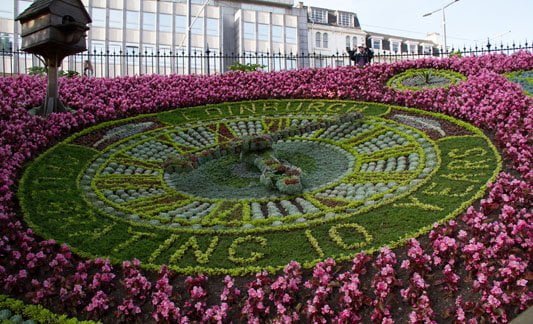
Designed with a different theme each year, it takes a couple of gardeners several weeks to lay out and involves up to 40,000 plants. Recreated the world over from Mexico to Switzerland, it forms the centrepiece of the Gardens and is a real treat to see in the flesh.
Other hidden gems worth exploring
The big city parks tend to get all the attention, but it’s worth seeking out so-called ‘pocket parks’ around the UK’s cities and towns.

For example, in the heart of London, nestled a stone’s throw from St Pauls Cathedral hides Postman’s Park. Built near the former Post Office headquarters and once popular with the postmen who worked there – hence the name – it’s a serene green bubble in the heart of the Big Smoke.
As well as providing a great place to escape the crowds if you’re in this part of London, it may provide some ideas for your own patch: a quiet bench and pergola or gazebo with ivy running up and the end of your garden could nicely recreate this garden’ soothing effect and be a real haven from the cares and stresses of life.

Another well-kept secret in the capital is the conservatory at the Barbican Centre. Although only open on Sundays, it houses a mammoth catalogue of over 2000 tropical plants, trees, and even fish. Should you fancy a visit, opening times are available here.

by Mark Bailey | Jun 25, 2018 | GardenLife Magazine

Playhouse ideas – how to build a playhouse for your kids
It’s a defining moment for every parent – the day your son or daughter asks if you’ll build them a playhouse (or a treehouse, if you’re lucky enough to have a mature tree in your back garden).
For the DIY gods of this world, it’s a wonderful excuse to get creative, unleash the power tools, and re-create the playhouse of your childhood – or childhood dreams. Some people will simply have endless playhouse ideas and designs.
But for the DIY phobics among us, it’s a defining moment for all the wrong reasons. Your ability to keep coming up with excuses won’t last, and it could be several years before the requests to build a playhouse or garden den finally subside. At this point your child will no-doubt have built their own stupendous playhouse in Minecraft, and their playhouse ideas won’t be hindered by DIY experience (or lack thereof).
So where to start? If you have basic DIY skills where do you get your playhouse ideas and inspiration from?
The dengineers – perfect for playhouse ideas
The fourth series of the CBBC series The Dengineers is being filmed in April-August this year, so will be hitting a TV screen some time soon.
For those of you who don’t know The Dengineers, it’s like Grand Designs or DIY SOS for kids. Each episode sees a crack team of designers and builders bring to life the den-dreams of an 8-12 year old.
A typical episode could see the dengineers build a back-garden den in the shape of a rugby ball; or a miniature wooden Scottish castle with turrets and working drawbridge; or a music playhouse with a façade like the front of a guitar amp.
They come up with amazing playhouse ideas and build them from scratch, or use an existing space such as an attic, basement or existing garden building. Materials are affordable and often recycled, and it’s great feel-good TV unless you happen to bump into your own inspired children shortly after an episode.
Building a playhouse or treehouse for beginners
So, if the next series of The Dengineers does get your family yearning for their own wonder-den, what can you do?
1. Consider the little playhouse details

Watch a whole episode of The Dengineers and you’ll see it’s the details that turn a den into a wonder-den. In the music den episode, for instance, it’s the addition of dials and a giant audio jack and cable that turn an ugly orange-framed box into a cool amp-themed den. And on the inside, serious sound-proofing turns into a serious rehearsal room, and a wall decorated with old vinyl give it a studio feel.
2. Don’t overthink your playhouse ideas

On the other hand, too much detail and too much interior design or furniture can spoil the best den or playhouse ideas.
If you think about it, your children’s den may house a toys’ tea party one day, and be a spy den the next. A pink palace may be great for the former, but not for the latter. So The Dengineers may accessorise down to the last detail for the sake of impressive TV, but you may not want to for your own den or playhouse ideas.
3. Everlasting playhouse perfection, or temporary fun?

Even the most digitally-fixated 21st-century kids can get caught up in the old-fashioned joys of building a playhouse. Not a DIY masterpiece with turrets or drawbridge, but a temporary lean-to made of old branches, wooden pallets, old tent poles, ripped sheets, and any other materials that can be borrowed or recycled. A living willow playhouse is also a great way to create a space for the kids without any DIY knowledge.

Almost as good are indoor dens involving tables, chairs, clothes horses and a variety of duvets, sheets and cushions, so the kids can take over a room for the day and pretend they’re invisible.
All you really need for a temporary playhouse, either outdoors or indoors, is an internal structure or framework, and things to drape over it. There are some good playhouse ideas on the Eden Project website.
4. If you decide to build a treehouse, do it properly
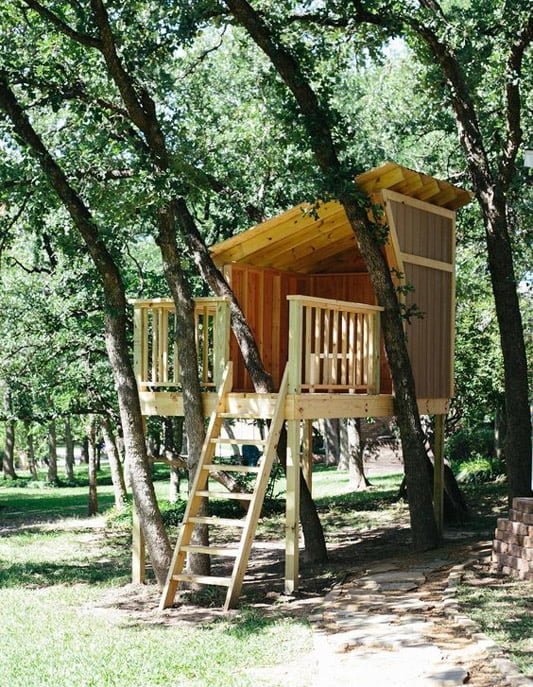
In books, memory and the imagination, treehouses are improvised affairs that materialise slowly as materials become available.
In most cases, that’s nonsense. Reach a bit further into your memories of those improvised treehouses and you may recall the broken arms and accidents involving damp wood or rusty nails that often came next.

If you do decide to build a treehouse, you need a plan, good materials and time on your hands (you may need planning permission too). There’s are good articles on the Independent and Dickies websites which will tell you all you need to know.
5. Take the lazy playhouse path

Simpler than coming up with your own playhouse ideas from scratch is to buy one. GardenLife Log Cabins has a good range of timber garden playhouses to catch any child’s imagination.
Designs include a miniature Alpine chalet for those that loved the book Heidi (or ski holidays!), a playhouse on stilts, or a design that looks like a Christmas gingerbread house brought to life, complete with tiny chimney, front ‘garden’ and porch.
All these timber houses are easy to assemble and built from sturdy Nordic timber and high-quality fittings, so certainly no issues with rusty nails and rotting wood.
6. Think beyond the playhouse

Finally, if your children are older, it’s a good idea to build (or buy) a design that can evolve – playhouse for the first couple of years, then teenage games room or music studio later on.
A flexible, plain timber building (either traditional or contemporary) that is flexible in terms of space and usage can easily be redecorated or re-themed at intervals to reflect the kids’ changing tastes. For example, if you buy a simple but solid garden building such as Vivian 3.8 sqm or Klara 4.7 sqm and paint it pink inside and out in years 1-3, and then re-design it with different colours and furnishings thereafter.
Hopefully with these playhouse ideas you can make your perfect den, be it a short-term lean-to, a beautifully original handmade playhouse, or a hassle-free off the shelf number delivered to your door.

by Mark Bailey | May 17, 2018 | GardenLife Magazine

The best gardens to visit this summer?
With the summer finally underway, the great outdoors has definitely become more enticing than in this year’s snowy spring. And in the long days of early summer, gardens across the country are often at their best.
Whether you’re looking for inspiration for your own garden, a day out, or somewhere to occupy children or visitors, here are some choices for the best gardens to visit this summer.
Great gardens in the South East

Think of an English garden in early summer and you’ll probably think of roses. In June, you’re spoilt for choice.
In Kent, Chartwell, the family home of Sir Winston Churchill, provides a textbook English combination of roses and history. The gardens include the Golden Rose Walk, a golden wedding anniversary to the Churchills from their grandchildren, with 32 varieties of yellow rose. Chartwell has to be considered one of the best gardens to visit if you’re into traditional garden design.
if you want to play at being a grandee for an afternoon, you can also hire out the Churchills’ croquet lawn.
More details about the house, gardens, and ticket prices are available on the National Trust website.
One of the best gardens to visit in the North East

If you’re looking for more northerly roses, try Alnwick in Northumberland.
There’s a rose garden with around 3,000 roses and a cherry orchard which is swamped with pretty blossom during the spring and summer months.
And thanks to its Harry Potter connections, its ‘poison garden’ (the only one in the UK), bamboo labyrinth and treehouse (Europe’s biggest), Alnwick is perfect for keeping younger visitors occupied.
More mature visitors can look at cascading water features and an ornamental garden once they’ve done with the roses, so it’s definitely an all-day trip.
It’s open daily from March until October and you can book tickets on its website, with various family concessions. Alnwick has to be one of the best gardens to visit if you’re in the north east.
Away from the crowds in Lincolnshire
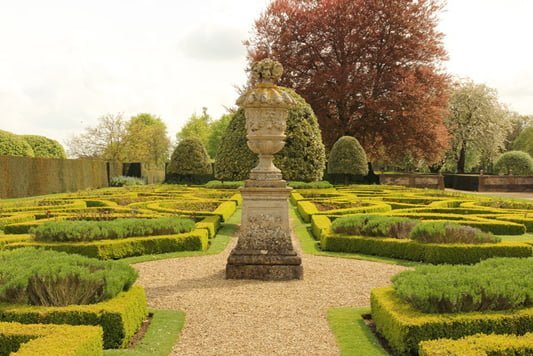
The ‘big names’ like Chartwell and Alnwick do tend to get crowded, but Britain is blessed with dozens of lesser-known but equally inspiring gardens (often missed off lists of “the best gardens to visit this summer”).
In rural Lincolnshire, for example, nestled deep in the countryside, the Grimsthorpe estate and gardens are far from the country cottage garden you might imagine.
Surrounding a thirteenth-century castle, these formal gardens boast immaculately-kept, topiary-laden lawns with intricate parterre landscaping.
And if you’re thinking about growing fruit, there’s an apple and pear garden where the trees are ‘espalier-ed’ onto wooden ladders, and also a collection of quince and medlar trees.
Grimsthorpe is open five days a week in June until September (or twice a week in April through May) along with the adjacent castle and park. Well worth a visit in summer.
Heading west towards Wales

Let’s head west now to the Welsh Borders.
A very manageable two acres of ornamental garden and two acres of woodland, Veddw House Garden is less grandiose than other formal gardens on this list.
But it has enjoyed much attention and praise in recent years from publications such as ‘The Good Garden Guide’ and from Alan Titchmarsh. and features an idyllic meadow and water features.
Any serious gardener heading for Wales would do well to visit the National Botanic Garden of Wales, near Llanarthne in Carmarthenshire. There’s inspiration for everyone here – a Japanese garden with cherry trees and tea house; a fuchsia collection, and if you were interested in our last month’s blog about encouraging pollinators in your garden, you should certainly visit the bee garden.
The best gardens to visit in Scotland this summer?

Now we go north to Scotland, where we recommend the Threave estate near Castle Douglas, in southwest Scotland.
There are 64 acres of sprawling gardens divided into distinct ‘rooms’. They include a rose garden, rockery, and a walled garden whose produce is available to the public. There’s a shop selling rare local plants and, if you’re looking for ideas for a water feature, you’ll certainly get new ideas you can take home.
What’s more, Threave is a paradise for wildlife enthusiasts – you’ll find Scotland’s only bat reserve, along with peregrine falcons, waders, kingfishers and ospreys on the neighboring nature reserve which makes up the wider Threave estate. Definitely one of the best gardens to visit this summer.

If ever you thought of Scotland as being too cold for serious gardening, take a look at Inverewe, way up north in the Scottish Highlands. Thanks to the Gulf Stream (and some brilliant garden design using walls to provide shelter from the wind), you have rare species you’d never expect to find in Scotland, including amazing Californian redwoods.
The gardens are designed to be attractive all year round, but summer is the best time to visit from the point of view of getting some decent weather. And though Californian redwoods may not be ideal for your own garden, Inverewe is a lesson in ambition, resourcefulness and thinking differently.
The best free gardens to visit in summer?
The cost of visiting these gardens and houses add up – especially when you’re likely to spend in their cafes and shops as well.
So it’s always good to have a list of great gardens that are free to visit.
Two favourite examples are in London and Edinburgh.
Regent’s Park

The chances are you’ve heard of Regent’s Park, but not as a place of horticultural inspiration. But it’s worth taking a look at the park’s Queen Mary Garden with more than 12,000 roses; the quintessentially Victorian Avenue gardens; and scores of allotments by a community garden.
The park spans 410 acres, so you’re unlikely to get bored in this refreshingly serene patch of green in the Big Smoke, and it’s certainly a rest for your wallet compared to other activities in the capital.
Botanic gardens

Another wonderful free garden is the Royal Botanic Garden in Edinburgh. There’s something to see all year round, but its summer highlights include splendid herbaceous borders, rock gardens, and amazing water lilies in the ponds in the glasshouses (some with leaves over 1.5m in diameter).
If you’re looking for other ideas for inspirational gardens to visit all around the UK, you’ll find some ideas at:
There truly are a vast number of gardens to visit in the UK, but hopefully our list of some of the best gardens to visit this summer should help narrow the choice!

by Mark Bailey | Apr 18, 2018 | GardenLife Magazine, How to guide

Gardening for bees and planting for pollinators
Would you like an excuse for a few weeds and untidy areas in your garden? Well you have a brilliant one; bees.
Or rather pollinators – because contrary to popular belief, it’s not just bees that pollinate our gardens, but various flies, beetles, butterflies, ladybugs and moths as well.
Basically, any insect that flies from flower to flower to feed themselves or their larvae is helping your garden grow.
It’s well known that bees are having a hard time at the moment – hives are under attack from parasites and disease, and pesticides can harm them (and other pollinators) – hence the EU banning the use of neonicotinoid insecticides.
So, what can garden owners do to save our bees and other insects? And why does it matter that we do this?
To start with the final question, it matters because without bees or pollinators, most of us would struggle to get the food we need. About one-third of the food on our plates is dependent on pollination (there’s more about this – and about what pollination actually is – on a good BBC website article about whether we’d starve without bees).
If you’d like to do your own bit to safeguard the UK’s crucial pollinators, what can you do in your own back garden?
Here are six steps covering gardening for bees, planting for pollinators and other ways to help butterflies and insects to their thing.
1. If you’re looking for a great hobby, you could keep bees yourself

The British Beekeepers Association offers advice and training courses all around the UK, if you’d like to have your own hives and honey sources.
But for most of us keeping our own bee hives is a step too far. And anyway, not all bees and pollinators are hive-based. The habitats of solitary bees, hoverflies and other insects are under threat not just from changes in agriculture, but from people making their gardens too manicured or – even worse – covering them with low-maintenance gravel or decking. Therefore you could consider gardening for bees and…
2. Make your garden bee-friendly with plenty of pollinator nest sites

Good habitats for pollinators include dead wood, ponds, and bare ground. This is a great excuse for a touch of neglect or organised chaos, and with more pollinators around, the other parts of your garden are more likely to thrive.
Some types of solitary bee nest in hollow stems, such as bamboo, or herbaceous plant stems, so incorporate these into your bee garden design too. You could drill holes in fence posts or logs, or make (or buy) your own bee hotel with bamboo canes or cardboard tubes.

Whether you buy a bee hotel, or make your own, be sure to position it somewhere sunny.
The RSPB has a good guide to building your own, and there are plenty of ready-made designs on websites like notonthehighstreet.com (and they make excellent gifts for gardeners who have everything).
3. Planting for pollinators; choose nectar and pollen-rich plants

We all know pollinators like flowers, but there are some finer points to note here.
Firstly, go for diversity in your planting. One threat to pollinators has been the move towards monoculture – so gardeners can counter this by planting a rich array of different flowers, and also letting some wildflowers grow.
Secondly, bees generally prefer open-flowered varieties of plants to fancier, double-flowered ones, because the latter tend to prefer less pollen and nectar.
Thirdly, according to Gardeners World magazine, bees see purple more clearly than other plants. This makes lavender, alliums, buddleia and catmint great bets for pulling in the pollinators.
If you want to know more about different bee-friendly flower varieties, take a look at a great gardening guide from Defra (Dept for Environment, Food and Rural Affairs) which even tells you which flowers appeal to long-tongued and short-tongued bees respectively!
4. Gardening for bees goes beyond the summer months

Another way to do your bit is to plant early and late-flowering plants. This will also make your garden look better for longer.
Early-flowering plants could include fruit trees, hawthorn, forget-me-nots, hellebores and crocuses. And this may be anathema to those who have battled dandelions for years, but they too (along with white deadnettles) can be good early sources of pollen and nectar.
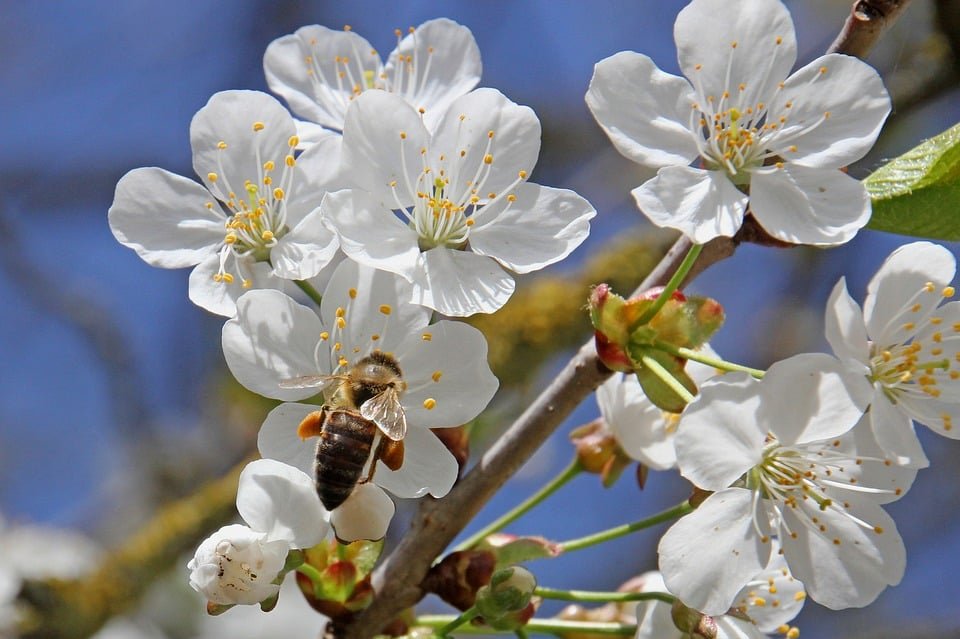
When it comes to gardening for bees and planting for pollinators good late-flowering plants include dahlias, fuchsias, sedums, Michaelmas daisies, sedums and marigolds – all of them easy to grow.
And remember, “a weed is just a flower growing in the wrong place”, so maybe a few dandelions, daisies and buttercups could go ignored the next time you consider getting the weed killer out.

For a more encyclopedic guide to planting for bees and pollinators, take a look at the RHS Perfect for Pollinators lists of garden plants and wildflowers.
5. Yes to gardening for bees means no to using pesticides

The arguments rage about the effects of pesticides on bees and other pollinators. But basically, if you can avoid them, do so, and use other methods as far as you are able – for example, organic products or biological methods. Hoverflies and ladybugs are both pollinators, but they also feed on aphids )a common pest that most gardeners try to get rid of).
If you must get out the pesticide sprays, avoid spraying on open flowers, and follow label instructions carefully.
6. Pollination can be thirsty work

Bees and other pollinations will often need to drink in summer, so the RHS recommends using a shallow dish filled with stones or marbles and water as a safe water source for them. The shallow edge of a pond can also be a good water source.
So, there we are, gardening for bees and planting for pollinators in six really easy steps. These suggestions can improve your own garden, but they’ll also help with global food security and biodiversity as well. That surely must be on your gardening to-do list for 2018.

by Mark Bailey | Mar 16, 2018 | GardenLife Magazine
The phrase ‘timber buildings’ doesn’t usually evoke thoughts of unconventional and impressive architecture – generally people will think of a log cabin or garden shed. But there’s a huge variety of inspirational and unusual timber buildings which push the boundaries of design. We thought we’d show you some examples so you can weigh up whether they’re worth investing in, or would work in your garden (or intriguingly on a lake or river)!
A tiny timber house that floats

First up in our collection of unusual timber buildings is a tiny off-grid house with a twist – it floats. Despite being clad in blue tinted aluminium, giving it a modern Scandinavian aesthetic, it’s made of laminated timber and insulated with dense foam for warmth; it’s also powers itself via solar panel meaning there’s no need for pesky wiring (difficult anyway when you’re off-grid).
It’s far from large though, with a floor space of 16 square metres making it spare bedroom sized, though there’s a deck with pontoons for access. Being prefabricated, this would relatively easy to build or buy if you have the money and somewhere to float it. Although we’ve never tried it ourselves, you could from buy a timber building from GardenLife and erect it on a floating platform!
And another floating timber living space

Continuing with the theme of buoyancy – and definitely a contender for winner of the “unusual timber buildings that float” prize – our next unusual timber building is a wooden houseboat complete with roof terrace.
Slightly more spacious, at 23 square metres, it too is fully insulated and even available on Airbnb complete with a video from its creator. The rooftop makes it perfect for sun lounging (subject to weather!) as long as you have access to the money, time and location for a timber building of this type.
Truly one-off unusual timber buildings
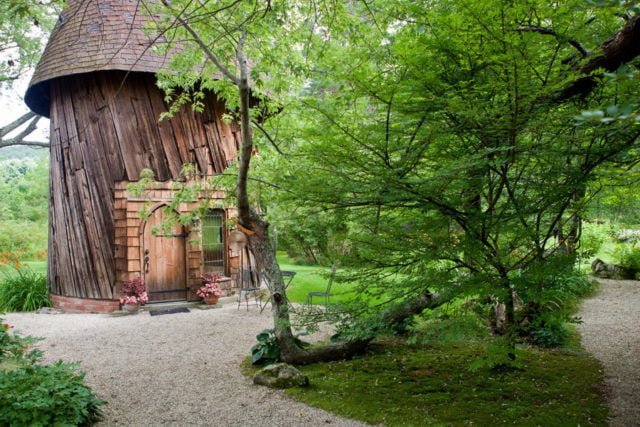
Next on our honour roll of amazing wooden buildings is this remarkable ‘silo cottage’. It’s very much a one-off, with its cone shaped roof reaching nearly 40 feet. You can rent it on Airbnb and experience for yourself its intricate timber-latticed staircase and cosy wooden stove.
Although it’s an enviable design, unusual timber buildings involving such unconventional shapes are certainly a bit much for anyone considering themselves less than an expert in construction and woodworking. A cheaper, simpler and quicker option would be a GardenLife Quick Fit self assembly garden room.
An unusual timber garden home
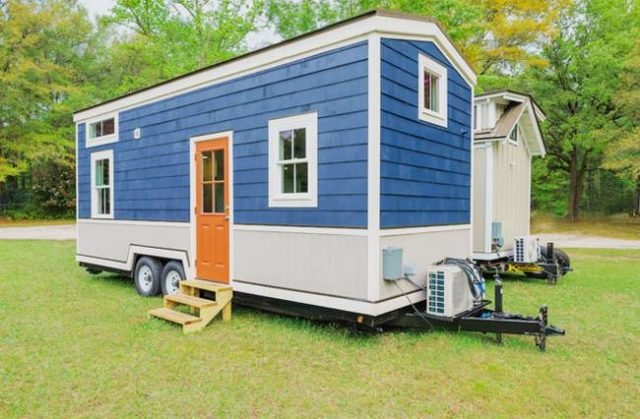
Simpler to achieve is this timber family home, which has two bedrooms (one of which doubles as an office-space with fold-away bed). The structure itself isn’t unusual – it’s basically a trailer – but it shows how creative use of colour and paint can turn a conventional timber cabin into a real-life version of a Playmobil house. Young children would love it as an extra living space or holiday home.
An unusual timber building that only engineers would think of
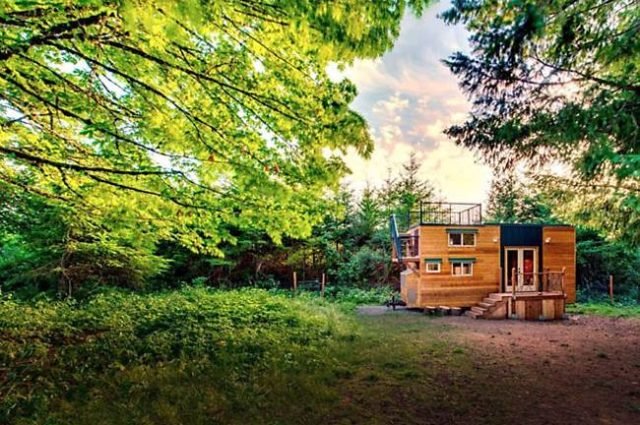
More unusual and architectural is this inventive home-cum-storage unit with two floors and even a rooftop deck. Raised off the ground to prevent damp, it was built (perhaps unsurprisingly) by two engineers and even features a second loft bedroom and compact living and storage space.
Accordingly, the design is perfect for space-starved gardens though you could probably live in it full-time as it’s as equipped as timber buildings come. Planning permission might have to be considered though, considering its height.
An unusual wooden building-and-greenhouse

Next is a pocket-sized timber country home, with its own greenhouse/self-contained garden. A roomy 30 square metres, it’s essentially an enormous trailer clad in timber and steel.
With air conditioning and fancy kitchen appliances, it probably belongs more in the category of ‘home’ than garden building. And the trailer design won’t be to everyone’s taste, but the raised flower beds and greenhouse are perfect for keen gardeners though.
A recycled timber hideaway
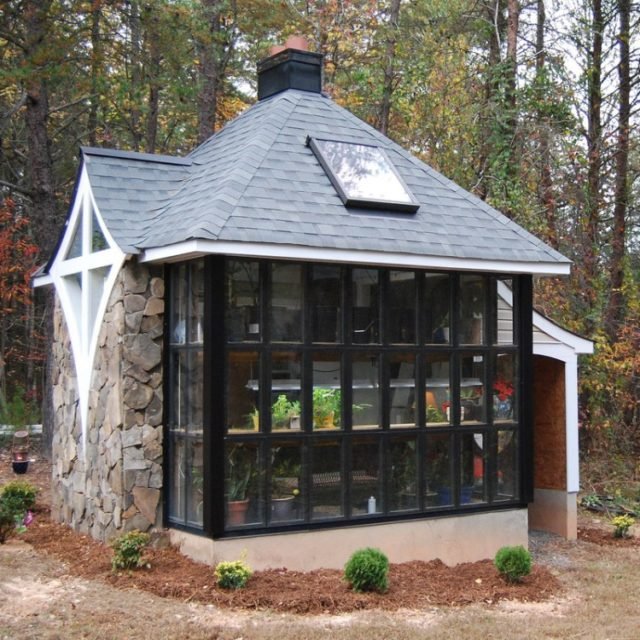
Perhaps a more realistic example of what can be built without help from a designer or architect is this timber cabin/greenhouse built of wood and recycled windows which create a shop window-style display of the plants within.
The space is tiny and it’s never going to appear on Grand Designs, but it’s a wonderful example of what you can achieve with a tight budget and a spirit of enterprise. It would make a unusual timber gardening retreat, guest-room or children’s playhouse. Definitely one of our favourite unusual timber buildings.
A wooden eco-building for cold climates

Ideal for those in less forgiving climates, this trailer-style eco-house comes complete with a drawbridge porch. It’s cold-proof, designed for off-grid living, and is also more flexible than some of our other unusual timber buildings because it’s easily towable. The interior is tidily organised for maximum floor space. Along with a few others, this belongs in the “transportable unusual timber buildings” section.
A timber cabin in the woods

Very different in style is this Hobbit-style Geodesic dome cabin built with reclaimed timber and natural plaster, to create a nature-centric, hideaway
This is certainly the most DIY, and escapist, structure in this list and although it’s not exactly spacious, it does fit a wood stove, a bed platform and a desk. Not perhaps somewhere to relocate to permanently, but definitely a beautiful weekend retreat.
Despite the diversity of their design, there is one thing all of these unusual timber buildings have in common – they’re quite significant undertakings. If you don’t have the necessary time, effort or expertise you might want to think again and browse the GardenLife website, where all the hard stuff is done for you.
Photographs from www.goodshomedesign.com
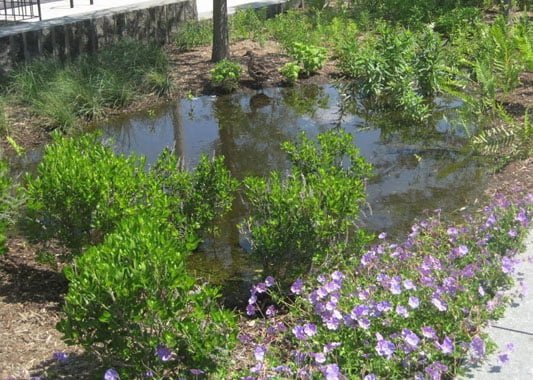
by Mark Bailey | Feb 14, 2018 | GardenLife Magazine

Your rain garden guide – construction, location, plants and more
We’ve talked about climate change and garden design on this blog before, and given pointers on how it might impact your garden. So now we’re going to continue on the theme, and discuss how we (or our gardens) could deal with a whole lot more rain.
For some of us, it will come into the form of heat and drought during the summers and torrentially wet winters with storms and flooding. For others, it will mean warmer, wetter weather all year round.
Either way, gardeners, wildlife watchers, water companies, and others are adopting the idea of the rain garden as a solution to all this excess water.
What is a rain garden?
Put simply, rain gardens are a sunken dip with plants and vegetation which collect run-off water, from your roof, patio, other hard surfaces, or overflow pipes. Crucially, they do this before the run-off water overwhelms your local drainage systems and leads to flooding.
They basically mimic the ups and downs of the natural landscape (before we covered it over with paving, roads, patios, car parks, patios!) and have plants that don’t mind their roots being waterlogged for a few days at a time.
The advantages of having a rain garden?
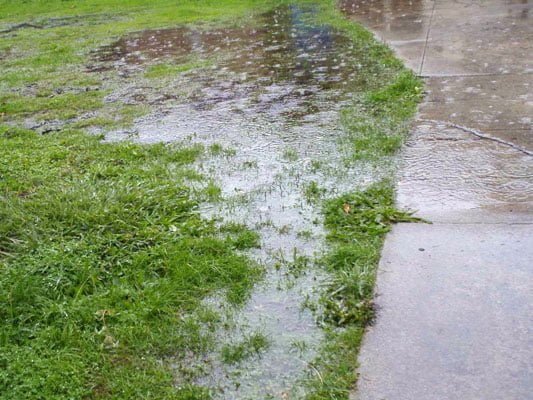
As you trudge through your boggy garden after a week of rain, you may feel you already have a rain garden. But planning a rain garden could transform a mudbath into something wonderful – a view to savour from your home or a garden room.
The great thing about a rain gardens is, they’re relatively easy to plant, and even easier to maintain. And in both respects, they’re a simple alternative to installing a garden pond (though it’s not actually a case of either/or, as they can look brilliant in combination).
Rain gardens can absorb up to 30% more water than a lawn, and don’t need mowing. And by reducing the risk of flooding, they also reduce the pollution risks associated with flooding (because run-off washes oil, metals and pollutants from roads etc into watercourses).
They can also be used to harvest rainwater, helping to reduce the effects of drought and cut down on the need for watering (another way in which they cut down on labour).
And, last but not least, it turns out there’s a huge choice of herbaceous and perennial plants that love to have a soggy bottom (see below). And also that many of these rain-tolerant plants are attractive to birds, butterflies, bees and other wildlife. So add biodiversity to the list of benefits.
What’s the best location for a rain garden?
Before you start digging a rain garden into a lawn or flowerbed, it’s important you know if and where any subterranean cables or pipes for gas and electricity etc. are in your garden. It’s best to avoid digging into them!
Secondly, it’s recommended not to site a rain garden within (3m) 10ft of a property – you don’t want water to do awful things to your foundations.
Rain gardens are not recommended for slopes with an incline of more than 10%. And don’t put one too close to a garden room or office in case there is overflow into the base area for the building.
Other than that, the main advice for positioning a rain garden is that it should be in full or partial sunlight (otherwise you may just end up with a swamp). And if you already have a natural dip in your garden, that could be a good starting point.
For more detailed advice about location and construction have a look through this user-friendly guide.
What’s the best soil for a rain garden?

The Royal Horticultural Society recommends a simple test to find out if your soil is suitable for a rain garden.
You dig a hole about 25cm (10 in) deep and fill it with water. Wait for it to drain away, then fill it up again, and watch how long it takes to drain. The RHS say an ideal rain garden site drains at a minimum of 1.25cm (0.5in) an hour. It should also be fine with absorption rates of up to 5cm (2in) an hour.
If it takes longer, your soil is not suitable – you might have a heavy clay soil, for example, or a high water table.
There are other variations on this test online, but the general idea is similar.
How big should a rain garden be?
It depends on the size of your garden overall, the level of drainage, climate, and the size of your run-off point (likely your roof).
The general rule of thumb is ‘the bigger the better’, especially since smaller ones are more prone to water logging and less able to prevent large run-off into drains etc. Again, the RHS website has some practical advice.
What plants are recommended for a rain garden?

There’s a surprisingly wide choice of easy-to-maintain plants – herbaceous perennials, in particular – that thrive in wet ground. Generally, you want to plant a broad variety of species with strong and dense roots to ensure absorption of water.
The main plants to avoid are Mediterranean species such as lavender whose roots are water-averse, or plants such as azalea which are prone to root rot.
The London Wetland Centre website has some excellent ideas for planting, and there are extensive lists of plant recommendations on the RHS website.

Wildflowers can also grow well around the edge of rain garden, and can help attract wildlife. There are some good ideas for wet soil wildflowers available here.
With these lists in hand, you’re well on the way to a climate-adapted garden that will not only be better for the environment than flooded hard surfaces or a boggy lawn, it will also be less stressful and look better – whether you’re enjoying the view from your kitchen window or relaxing in a garden room.
Too much rain? Not a problem. For the gardener at least.

by Mark Bailey | Jan 10, 2018 | GardenLife Magazine

Hygge garden design? The lagom garden concept? Transform your garden in 2018
No, they’re not names of shrubs, but Scandinavian lifestyle trends. Hygge’s probably the best known but forecasters say that lagom, ikigai or even còsagach could well displace it in 2018.
Because each word encompasses a concept that crosses over anything from wellbeing to design, to eating and drinking, to how you spend your free time, they really could transform your life as well as your home or garden.
So, we’ll do a whistle-stop guide to what each concept means, and then we’ll give you ideas for incorporating them into your own garden.
Hygge garden design?
Hygge is Danish, and it’s all about the idea of coziness, conviviality and being comfortable in the moment. It’s opened a way for a range of self-indulgences, from drinking hot chocolate with friends, to homes filled with cashmere throws and a wardrobe to match. Being Scandinavian, there’s a sense of moderation and good taste around it, though – think contentment rather than mad-for-it hedonism.

Hygge’s easy to visualise inside a café or country pub, but do you get hygge into a British garden – particularly as the chill winds of winter blast through the gaps in your fence?
Think garden buildings. Natural timber, well-insulated from storms and winds, a snug space away from household chores and the stresses of work – a timber cabin could be the perfect hygge addition to your life.

A great example of hygge cabins, on an affordable budget, is our Claudia pavilion – with windows on three sides to let in natural light; dense Nordic timber to keep out the chills; and a space that’s cozy without being claustrophobic.

Another perfect retreat is Melanie – a clever shape that fits into a corner in your garden, with light coming in on three sides – but not Arctic-style draughts, thanks to double glazing. It comes in a choice of two sizes, so you can choose how many people who want to get hygge with. The larger version of Melanie (9.6 sq m) has 44mm wall timbers – idea for keep cosy whatever the winter weather.
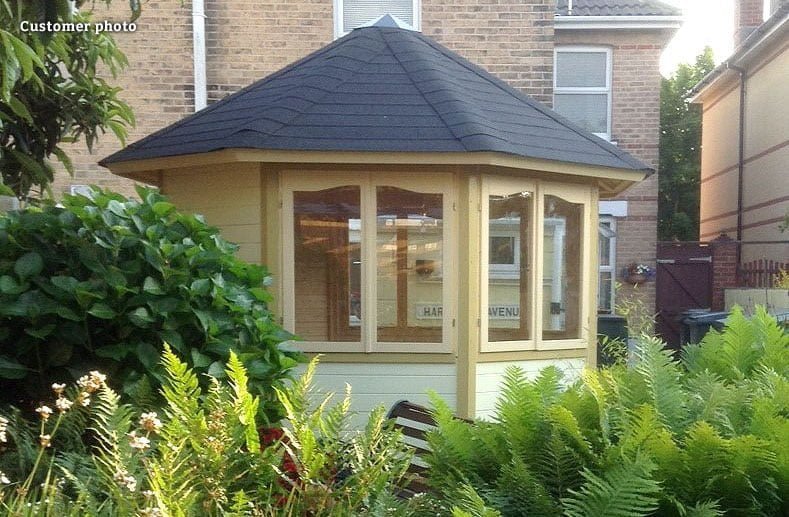
And then there’s Veronica. With an octagonal design, it is reminiscent of a sauna hut, but the double windows allow in more light – giving you a connection to the outdoors, and making it great for summer use as well as a space to hide away in during winter. Like Claudia, it’s compact, so it won’t eat up too much of your lawn or borders, but with 6.7 sq m of space, you’re still have space to lounge over your fika (Swedish for a coffee with a cake or pastry and preferably a chat as well).
If you want to go full tilt for the sauna vibe, how about a Scandinavian barbecue hut like our Eva design (customer photo just below), with bench seating around the edge, a BBQ grill and smoke extraction hood, and 44mm insulated walls to help keep everyone toasty all year-round?
The lagom garden concept?
Before getting too wholeheartedly into a daily fika habit, it’s worth thinking about lagom, another lifestyle trend for 2018. Lagom is used in many different contexts, from eating to ways of doing business to eating to lifestyle choices, so there’s not one-translation-fits-all. The general idea is “everything in moderation”, avoiding excess in anything from work to play to diet to being too ‘Me, me, me”.
So, how does this translate into garden design and garden buildings? Rather than letting work, commuting or retail consume your 2018, how about finding a garden refuge where you can be healthy, happy and content – whether spending more time with family or friends or taking up a new hobby?

Another element of lagom to incorporate in your garden is the design aesthetic. For example, the classic stripped-back Scandinavian colour palette of chalky matte paint, milky whites, blue-greys, and stone, spiced up with small splashes of dark red, brick or yellow, is very lagom, and would work beautifully with any of these garden buildings – both exterior and interior.
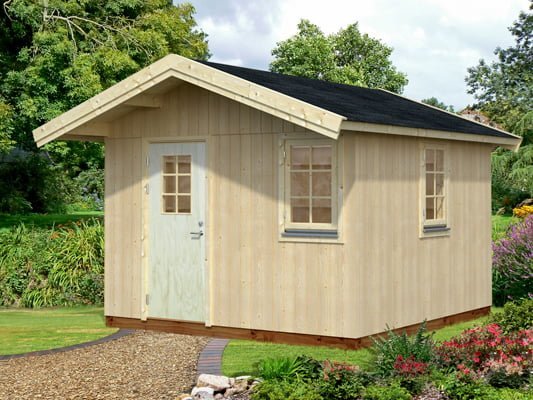
We also sell a selection of easy-to-build models whose design is Nordic-influenced. Hedwig is a Quick Fit design inspired by Swedish summer houses – simple, sturdily built, pastoral. Add some red paint on the exterior and you could be in a Scandinavian forest or island.
For a more urban and contemporary aesthetic, take a look at Ly. Spacious (with 10.2 sqm of floor space, or 13.6 sqm of space if you go for the largest model) but still Nordic-influenced in its functionality, comfort and pared-back aesthetic. It makes a great office or workroom – the placement of the windows means you get plenty of light without being on display.
An ikigai garden?
Another trend for 2018 is the Japanese idea of ikigai. This is less about interior design, more about how you live your-life. As with lagom, it’s difficult to find a direct translation, but suggestions range from ‘self-realisation’ to ‘what gets you out of bed in the morning’. It’s about what gives meaning to your life, and according to the Wikipedia guide to ikigai, this could be anything from work to having children to hobbies.
To our minds, there’s no doubt about it: ikigai means having a shed. Or man/woman-den, garden building, workroom – call it what you will. You could use it as creative studio, gym, brewing shed, games room, or a garden office to start the business you’ve long daydreamed about.

A timber cabin like Ines can be perfect here – it’s an elegant design, with clean lines and no over-the-top design details, and we’ve heard of people using it as anything from an extra living room or breakfast room, to a garden gym or yoga retreat. With 44mm walls and double doors that open wide, it can be as snug or airy as you wish.
Getting “còsagach” in your garden?
Our final word for 2018 is còsagach. Announcing it as a lifestyle trend for the year, VisitScotland translated it as snug or sheltered, and encouraged businesses to create environments that “induce a feeling of warmth or cosiness”.

Unfortunately, the choice of còsagach also reminded us of the dangers of adopting hard-to-translate foreign-language words as lifestyle themes. VisitScotland’s advice aroused a backlash from Gaelic speakers who said còsagach in fact means ‘a damp mossy place’ or ‘a wee nook or hole such as very small creatures might live in’ – one person mentioned woodlice.
Not something to aim for when you’re choosing a garden building; best stick with hygge garden design or the lagom garden concept!





















































































